Fuzhou Lacquer Art, the “Black Gem of the East”: A Journey of Renewal and Rise
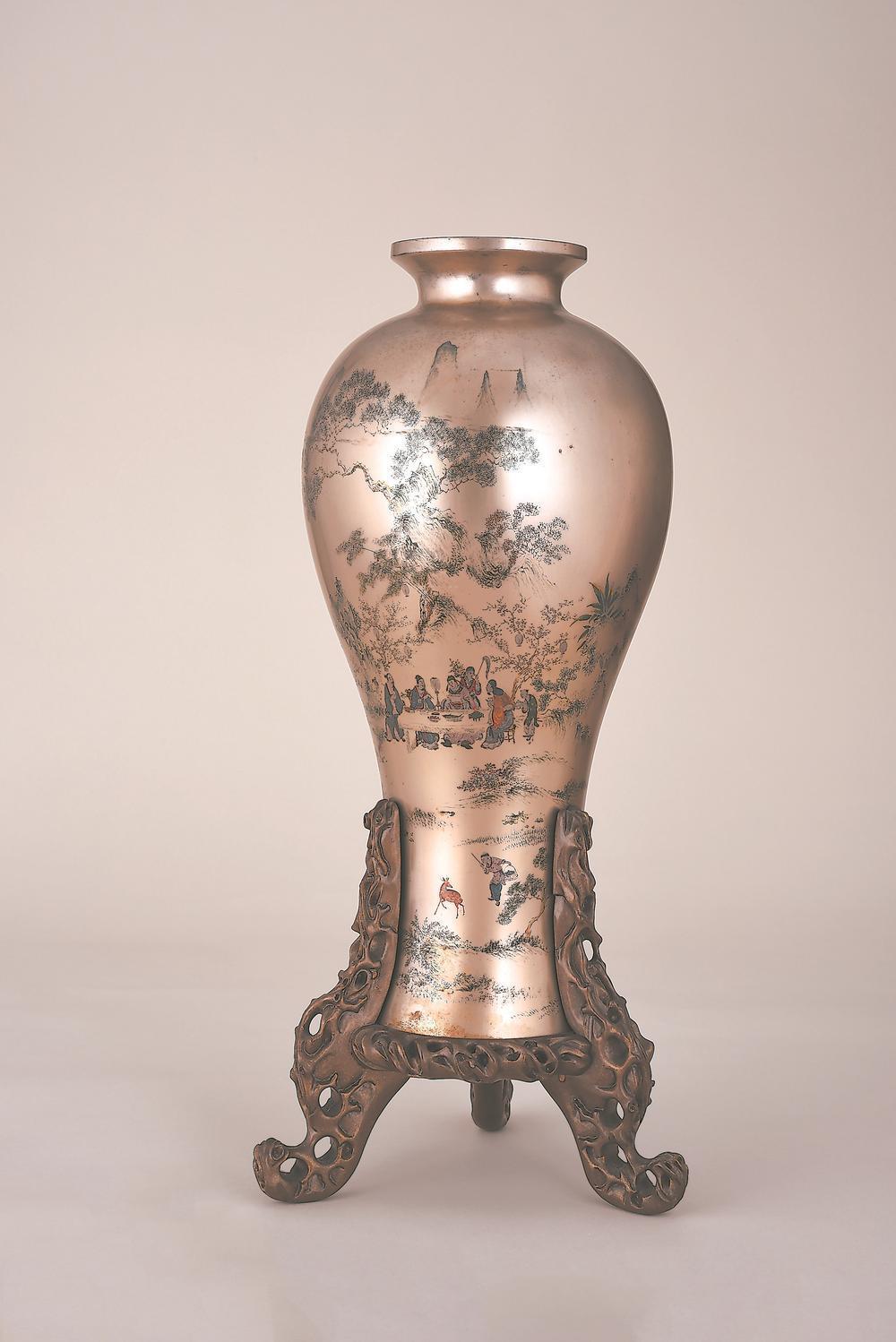
Shen Shaoan’s “Lan Ji” Silver-Lacquered and Painted Plum Vase Depicting the Xiyuan Gathering (Photo courtesy of the Shen Shaoan Lacquer Art Museum)
Highlight
Recently, the celebrity influence of Li Ziqi and Zhao Liying has once again brought Fuzhou lacquer art into the global spotlight.
Blessed with favorable geography, Fuzhou has been a prominent hub for lacquerware craftsmanship since ancient times. By the late Qing dynasty, its bodiless lacquerware was acclaimed as the “Black Gem of the East.”
After the founding of the People’s Republic of China, Fuzhou lacquer art masters pioneered innovative techniques such as the “Tanyan Technique” and “Fuyin Technique,” which have since been widely used in Chinese lacquer painting. Lacquer art was introduced into higher education, leading to the establishment of lacquer painting as an academic discipline. Artists like Qiao Shiguang incorporated contemporary painting ideas and techniques, transforming lacquer art from decorative objects to works on canvas. With its distinctive artistic style, Fuzhou and even Fujian lacquer painting gradually rose to prominence as a national leader in the field.
In 2006, the bodiless lacquerware painting technique in Fuzhou was listed among the first batch of national intangible cultural heritages. Since then, both provincial and municipal governments have introduced a series of policies to support its preservation and development, with initiatives ranging from skill transmission and talent training to market expansion — all contributing to the continued vitality of this traditional art form.
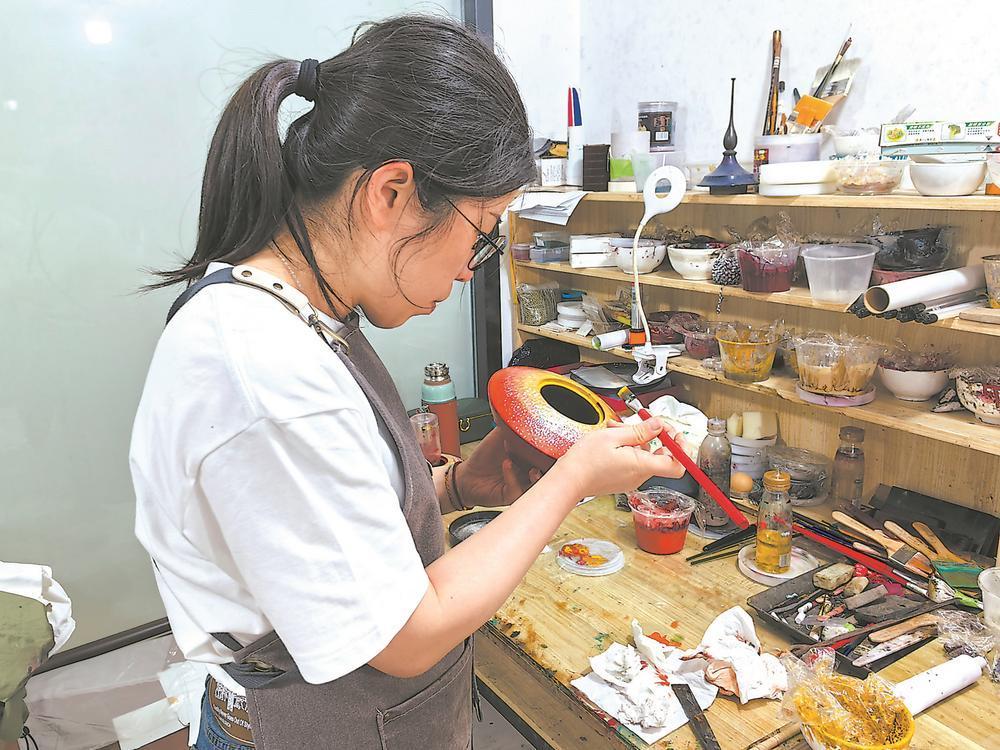
A lacquer artist was carefully inlaying mother-of-pearl into the lacquerware.
From Household Craft to Citywide Art
Master craftsmanship is never achieved overnight, nor does it remain unchanged. Fuzhou lacquer art, which traces its roots to the Song dynasty, is a perfect example.
On the eve of Lixia (the seventh solar term in the traditional Chinese calendar, which marks the official start of summer), the reporter visited Lacquer Creative (Fujian) Culture and Art Co., Ltd. in Minhou, Fuzhou. There, lacquer artist Wang Yiping was fully focused, delicately inlaying tiny mother-of-pearl pieces, each about the size of a grain of rice, onto the surface of the lacquerware. Bathed in the slanting sunlight, the red lacquer vase began to shimmer with vibrant hues. After a final layer of glossy lacquer is applied and the surface is polished smooth to reveal the inlaid pieces, it will become a stunningly colorful mother-of-pearl lacquerware masterpiece.
“According to historical records, Fuzhou was using mother-of-pearl inlay techniques in lacquerware as early as the Song Dynasty,” explained Zheng Pin, a master of Fujian lacquer art and Executive President of the Lacquer Art Research Institute at Minjiang University. During the Southern Song period, Fuzhou not only produced lacquerware but also developed a distinctive carved lacquer technique known as “tixi.” By the late Ming and early Qing Dynasties, Fuzhou’s carved lacquer had earned widespread acclaim. As Li Yu noted in Xianqing Ouji (Leisure Notes), “During my visit to the three mountains, I saw countless carved lacquer pieces... The art of carved lacquer has flourished in Fujian for centuries.”
During the Qianlong reign of the Qing Dynasty, Fuzhou lacquer art reached its pinnacle. Shen Shaoan, regarded as the pioneer of Fuzhou bodiless lacquerware, found inspiration while restoring a plaque for a government office. He successfully revived the long-lost Han Dynasty “Jiazhu” technique, and revitalized and advanced the bodiless lacquerware painting technique, marking the beginning of the era of Fuzhou bodiless lacquerware.
Traditional Fuzhou bodiless lacquerware is created by combining the bodiless technique with decorative lacquer art,” explained Liang Xiangming, a lecturer at the Shen Shao’an Lacquer Art Museum. To make bodiless lacquerware, artisans need to select suitable fabric or wooden bases, and then go through processes like ash coating, shaping, and finishing. After that, they decorate the piece using techniques such as gilt shading, brocade patterns, and red lacquer with gilt decoration. This results in lacquerware that shines like a mirror with vivid colors, and offers advantages like water resistance, durability against deformation, and colorfastness. “From choosing materials to the finished product, the process involves dozens to over a hundred steps, with crafting and drying being very time-consuming. Thus, it often takes several months to complete a single piece.”
During the late Qing Dynasty and the early Republic of China period, Shen’s lacquer art gradually evolved from a family-based tradition into a brand-driven operation. This transformation became especially noticeable in the fifth generation when the Shen brothers broke with the old family rule known as the “Four Inheritances and Four Prohibitions.” Each of them established their workshop, competing with one another, and hired skilled artisans specializing in different techniques such as clay modeling, wood shaping, pattern sawing, carving, and lacquer painting. Notably, brothers Shen Zhenghao and Shen Zhengxun built upon their predecessors’ techniques to invent the “thin material” method. They ground gold and silver leaf into a fine powder and mixed it with lacquer. This breakthrough expanded the traditional lacquerware color palette beyond the usual red, gold, black, and silver, introducing brighter shades like light blue and pale yellow. This innovation significantly advanced the craft of bodiless lacquerware and marked the beginning of its golden era in Fuzhou.
During this period, Shen’s lacquerware not only saw the emergence of exquisite pieces and a growing production scale but also nurtured many acclaimed lacquer artists, including Li Zhiqing, Gao Xiuquan, and Zhang Jinhua. From 1898 onwards, the works selected by Shen Zhenghao and Shen Zhengxun were repeatedly awarded top prizes at major international exhibitions like the Paris International Exposition, earning Fuzhou lacquer art worldwide acclaim.
After the opening of five treaty ports to foreign trade, Fuzhou’s lacquer artists began producing Western-style items such as smoking sets, drinkware, coffee sets, and makeup boxes to meet both domestic and international market demand. According to historical records, by 1933, Fuzhou had 56 lacquer workshops and factories of various sizes, with an annual output value of 300,000 silver dollars, about half of which came from exports, making it the largest lacquerware production center in China at the time.
After the founding of the People’s Republic of China, Fuzhou lacquer artists introduced innovative techniques, including gemstone sparkle, raised lacquer relief, and bronze imitation. They also blended lacquer art with jade carving, stone carving, ivory carving, wood carving, and horn carving, significantly expanding the variety of styles and product lines. These creations, which include figurines, vases, fruit dishes, boxes, utensils, and furniture, now span 18 categories and over 1,200 unique designs. Many of these works of art have been presented as state gifts to foreign heads of state, serving as bridges of friendship.
According to Chen Tian’gan, President of the Fuzhou Bodiless Lacquerware Industry Association, Fuzhou, known as the “Capital of Chinese Lacquer Art,” is home to more than 1,000 businesses and independent artisans engaged in lacquer production and processing now. There are nearly 10,000 professionals in the lacquer industry, most of whom are under 45. Many are graduates of specialized art schools, bringing strong artistic expertise and fresh creative thinking to the field. Their market-savvy innovations are breathing new life into the industry and driving its continued growth.
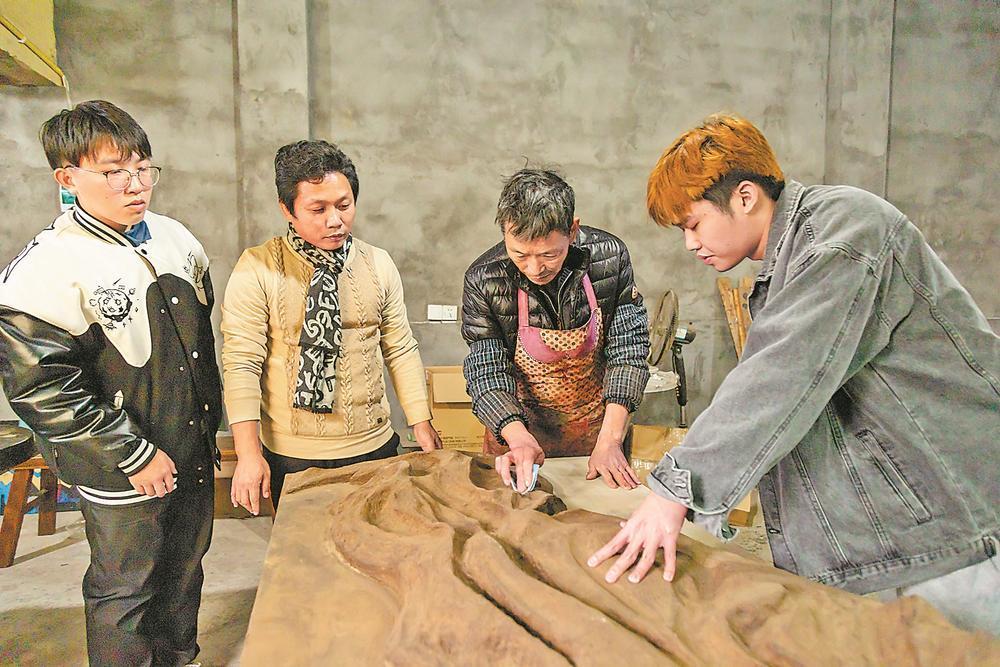
Students from Minjiang University were exchanging creative ideas with their instructor. (Photo courtesy of Minjiang University)
Pursuing the Beauty of Nature and Human Creativity
Shaping, lacquering, polishing... As spring gives way to early summer, Li Songtao, a graduate from the Painting Department of the Academy of Fine Arts at Minjiang University, is making his final push for his graduation lacquer painting series The Forty-Third, under the guidance of his mentor Liu Yao.
This young man, skilled at using traditional lacquer techniques to convey modern aesthetic sensibilities, earned awards during his university years for his lacquer paintings Contours of a World Apart and Bridge at the inaugural Chongqing Lacquer Painting Exhibition and the Fujian Province Comic Exhibition, respectively.
“Over the past four years, our teachers have guided us through a systematic study of Fuzhou’s traditional lacquer techniques. In this process, I gained a deep understanding of the diversity of lacquer art and was often moved by the surprises it brought,” said Li Songtao.
Diversity, the unique charm inherent in lacquer art, has captivated generations of lacquer artists. In his essay Prospects for Chinese Lacquer Art, Qiao Shiguang, a pioneer and founding figure of modern Chinese lacquer painting, described this diversity by saying, “The materials and techniques of lacquer art are abundant and varied, and its forms and styles of painting are diverse; as a result, the new expressions born from their combination are boundless.”
The Goldfish Lacquer Tray, crafted by Zheng Yikun, a national inheritor of the bodiless lacquerware painting technique and a Chinese arts and crafts master, is one of the iconic masterpieces of Fuzhou lacquer art. Viewed from above, the tray’s deep black background resembles a bottomless pool, with lacquer hues gradually shifting in tone and depth, creating a striking sense of perspective. Though there is no water, ripples seem to shimmer across the surface, and goldfish appear to swim within. Remarkably, these lively fish are actually painted on the tray’s vertical rim. When the piece was exhibited in 1963 at the Fujian Hall of the Great Hall of the People, renowned aesthetic critic Wang Chaowen wittily remarked, “It would drive cats crazy.”
The remarkable lifelike quality of Zheng Yikun’s Goldfish Lacquer Tray is chiefly attributed to his solid foundation in traditional fine-line painting and his ingenious handling of the fishtail’s proportions. He said, “The goldfish’s tail is like Odette’s flowing skirt in Swan Lake or Du Liniang’s long water sleeves in The Peony Pavilion. Without the delicate skirt or the gentle sleeves, how could such depth of love, grief, and passion be conveyed? It is the elegant, undulating tail that makes the goldfish appear more vibrant and lifelike.” Additionally, the effect is further enhanced by his expert command of lacquer techniques. He applied layers of translucent lacquer over the vermilion-painted fish patterns, then polished the surface with varying pressure to create layers of differing thickness and translucency. The result is a shimmering interplay of light and shadow, as if gazing into a pool of water—truly “painting the fish without the water, yet the waves appear naturally.”
The inherent diversity of lacquer painting naturally fosters the integration of various techniques.
“Lacquer painting is an exceptionally inclusive art form. It not only incorporates the brushwork and lines of traditional Chinese painting to express aesthetic sensibilities, but also draws on the color aesthetics of oil painting and the layered techniques of printmaking to convey ideas and emotions,” said Chen Jinhua, Director of the Lacquer Painting Art Committee of the China Artists Association and Vice Chairman of the Fujian Artists Association. He noted that the hallmark of successful integration lies in achieving harmony between painterliness and the unique qualities of lacquer, resulting in a beauty that resonates with both the natural world and human emotion.
How can we achieve this?
Chen Jinhua believes that “lacquer is the foundation of painting, and painting is the soul of lacquer.” First, artists must understand the very essence of lacquer painting. Though the creation process is tedious, with long production cycles, slow results, and higher demands on the studio’s skill level, lacquer artists should remain dedicated to the distinctive language of the medium. They should immerse themselves in traditional culture, explore the unique strengths of lacquer painting as an art form, and be committed to careful refinement.
Second, lacquer artists should place great emphasis on their choice of subject matter. Reviewing works from past National Lacquer Painting Exhibitions, many tend to lack conceptual depth, focusing heavily on technical mastery and relying too much on material effects to convey abstract ideas. “Lacquer painting should focus on realistic subjects, especially significant themes and figurative work, using lacquer’s unique charm to bring a distinctive vitality to the works.”
Additionally, artists should push themselves to create large-scale works. The visual impact of a large piece is unmatched by smaller ones. Furthermore, working on a bigger scale greatly strengthens an artist’s command of spatial composition, making it a rewarding and valuable challenge.
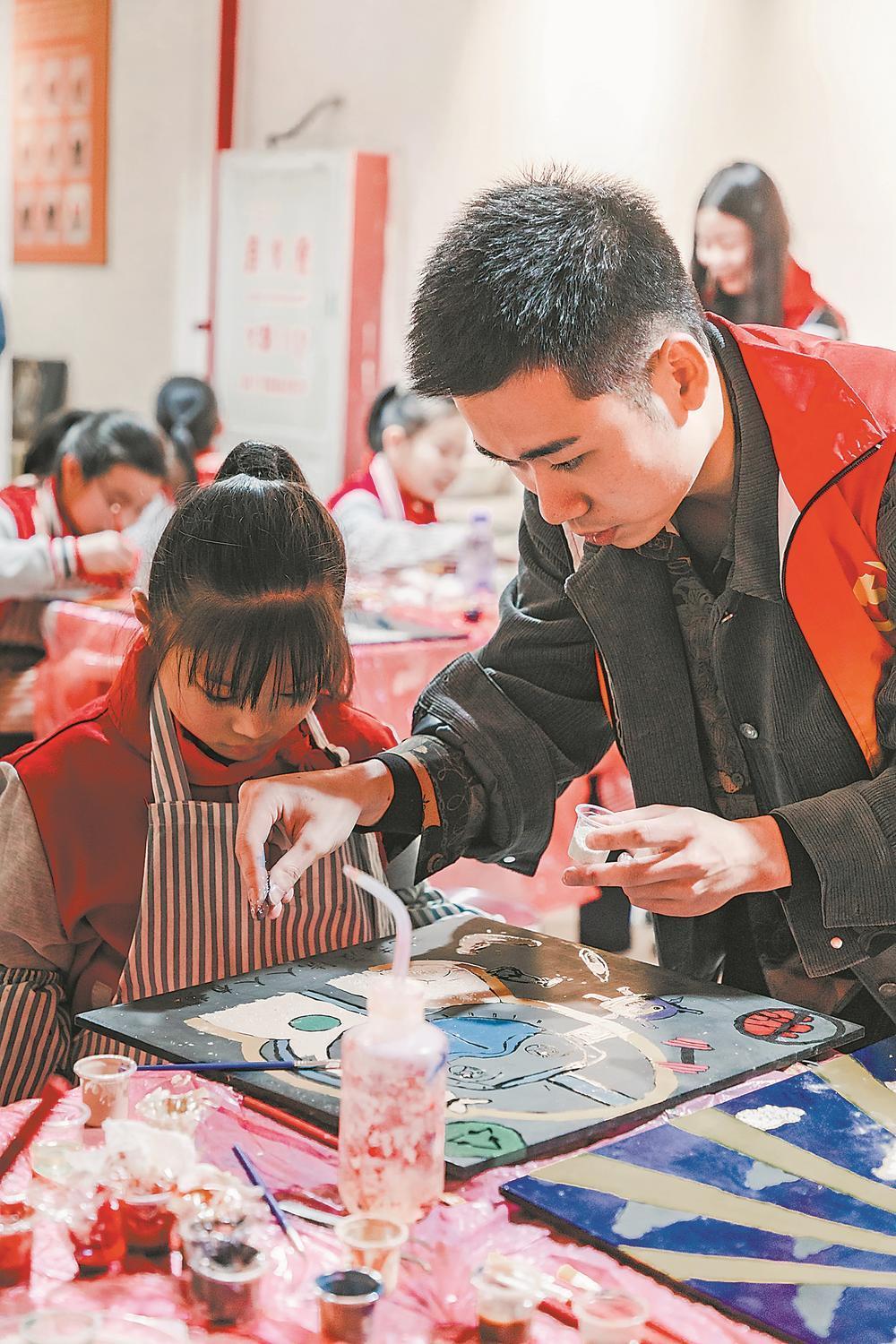
Lacquer Art in Schools.
Lacquer Art: Renewed Vitality, Growing Popularity, and a Bright Future
During the May Day holiday, the two bodiless lacquer vases at the Shen Shaoan Lacquer Art Museum were undoubtedly the star attractions of the Sanfang Qixiang Scenic Area, attracting a steady flow of visitors eager to admire and photograph them.
Chen Xinyue, a young woman from Taizhou, Zhejiang, born after 2000, came across a Fuzhou cultural tourism promo featuring film and TV star Zhao Liying just before the May Day holiday. Inspired by the video, she decided to visit Fuzhou and made sure to include the Shen Shaoan Lacquer Art Museum in her itinerary.
“At the museum, I not only discovered the rich history of Fuzhou lacquer art but also snapped photos just like my idol and picked up some unique lacquer-themed souvenirs. It was a truly rewarding visit,” said Chen happily, wearing “three hairpins” and dressed in red.
Hearing the praise from visitors, Shi Liling, curator of the Shen Shaoan Lacquer Art Museum, was delighted. She shared that over the years, the museum has worked hard to stand out by organizing exhibitions, competitions, cultural exchanges, study tours, and salons. “Relying on celebrity influence to promote lacquer culture is a pioneering effort for us,” she noted.
The growing interest in lacquer art is closely linked to robust support from government policies.
In recent years, the provincial and municipal governments have rolled out policies such as the Regulations of Fujian Province on the Protection and Development of Traditional Arts and Crafts, the Regulations of Fuzhou City on Bodiless Lacquerware Technique Protection, and the Fuzhou Lacquer Art Protection and Industry Development Plan. These policies provide support in areas such as strengthening craftsmanship inheritance and protection, enhancing talent development, and encouraging market expansion, all of which contribute to the preservation and sustainable development of lacquer art.
The Academy of Fine Arts at Minjiang University is renowned as the “Whampoa (Huangpu) Military Academy” for lacquer art talent. Its predecessor, the Fuzhou Academy of Arts and Crafts, launched a lacquer art program in 1956, making it one of the earliest institutions in China to establish a formal lacquer art education system. Professor Luo Fanglin, Vice President of the Lacquer Art Research Institute at Minjiang University, shared that to promote closer integration between industry and education, the university began exploring a “Lacquer Art+” teaching model over a decade ago. Beyond courses focused on lacquer art techniques, they also offer classes like “Lacquer Art Cultural Product Design,” “Corporate Brand Identity Design,” and “Decorative and Pattern Design,” all aimed at bringing lacquer art into modern life. Additionally, the university hosts the “Yiqi” cultural market, encouraging students to create lacquer-themed cultural products and providing an opportunity for faculty and students to better appreciate lacquer art through hands-on participation.
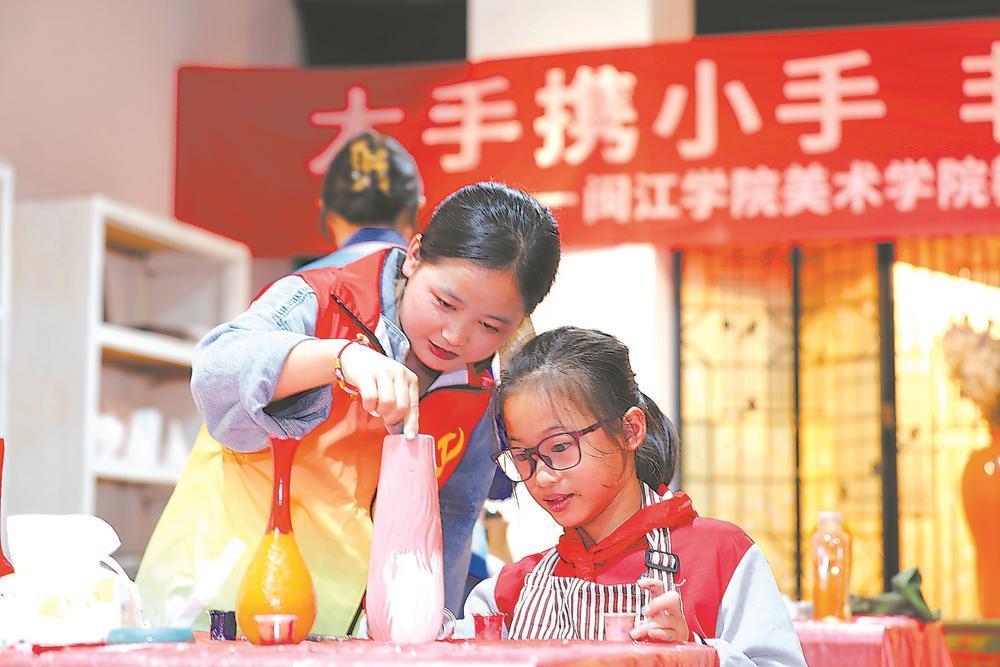
The faculty and students from Minjiang University’s Academy of Fine Arts took part in a lacquer art promotion event at Maipu Primary School in Cangshan District.
“To truly bring lacquer culture into everyday life, we must start with the children,” said Wu Sidong, a renowned arts and crafts master in Fujian and Director of the Painting Department at the Academy of Fine Arts, Minjiang University. In addition to teaching university students, he now also instructs a group of elementary school students.
Since 2021, supported by the university, Wu Sidong has spearheaded the establishment of “Lacquer Art Studios” at Maipu Primary School, Hongtang Central Primary School, and Taijiang Experimental Primary School in Cangshan District. Every Wednesday afternoon, faculty and students who are Party members from the Academy of Fine Arts volunteer to teach the children lacquer art. “It’s truly rewarding to see the children so dedicated to understanding and practicing lacquer art,” he said.
“We hope that both our works and those of our students can move beyond the campus and reach a broader audience,” said Liu Yao, a graduate of the China Academy of Art in Hangzhou. In the past two years, inspired by his alma mater’s experience in organizing graduation exhibitions, he has proactively partnered with several historic and cultural districts in Fuzhou. He aims to display lacquer art in venues with high foot traffic and a strong artistic atmosphere, achieving the dual goal of promoting lacquer culture and enriching the city’s cultural landscape.
“In recent years, the profile of Fuzhou lacquer art has continued to grow, with both locals and tourists showing increasing interest in learning about the craft and purchasing lacquer pieces,” said Zheng Pin. He urged the relevant authorities to take the lead in pooling resources and establishing a dedicated venue for the comprehensive display of Fuzhou lacquer art. Such a space would not only help the public better appreciate its history and development but also serve as a marketplace for lacquer works, hence fostering a shift from preservation to a shared cultural experience.
Preservation and promotion lay the foundation. However, moving forward, Fuzhou lacquer art must embrace innovation and explore new ways to connect with modern life.
Taiwan lacquer artist Huang Baoxian, a provincial-level representative inheritor of the intangible cultural heritage of Fujian bodiless lacquerware painting technique, has studied lacquer art in Taiwan, Japan, and elsewhere. In his view, local lacquer works still lack originality and rely too heavily on imitation. To address this, it is vital to focus on nurturing talent, strengthening education, fostering a more open artistic environment, and creating space for original work to thrive.
“Policy support and celebrity endorsements have breathed new life into the development of lacquer art. Yet, for lacquer art to truly achieve high-quality development, the key lies in its transformation. It needs to become part of everyday life,” said several lacquer art experts. (Fujian Daily Reporter: Zhang Jingwen, Text/Photo)